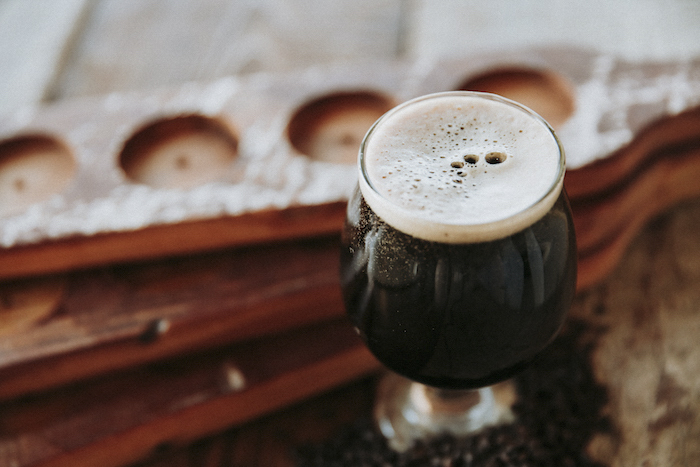In the land of beer, the talk of late has been about pastry beers. The unofficial category is essentially a doctored-up stout, hit with dessert-inspired adjuncts and making for some genuinely fun brews.
There’s a catchy, recreational element to the style. There’s no formal definition, but a pastry beer is basically a stout (or occasionally a porter or some other darker genre) hit with pastry-like things such as cacao, lactose, cinnamon, or coconut. Often, brewers try to mimic a favorite sweet tooth item, like chocolate cheesecake, key lime pie, or even Neapolitan ice cream. Brewers get to be kids again, borrowing the sugary enthusiasm of Willy Wonka as they try to craft something clever, playful, and tasty. The end result is jolly in its own way, too, often on the heftier end of the alcohol by volume spectrum.
Related Reading
- Best Beers
- Best Coffee Beers
Al Marzi, Chief Brewing Officer at Harpoon Brewery in Boston, says the in-form style makes darker beers all the more welcoming. “It used to be that stouts or other bigger, darker styles would scare more casual consumers off,” he says. “With pastry beers though, because the concepts are so familiar, it takes away that intimidation factor. Suddenly someone that might not go near a big ten-percent stout is thinking ‘oh, you mean this tastes just like chocolate cake? That actually sounds pretty nice.’”
Marzi and his team are behind Mike’s Pastry Stout, a beer inspired by some famous cannoli’s. They teamed up with Mike’s Pastry, the Bean Town institution that’s been at it since 1946, in making a stout and barrel-aged stout that drinks quite a bit like a cannoli tastes. The beer is made with real cannoli shells and is quite good, sipped on its own or even hit with a dollop of vanilla ice cream.

It’s one of a growing number of pastry beers coming to market these days. In Florida, 3 Sons Brewing is turning out Scoop, a balanced imperial stout built around the trilogy of ice flavors—strawberry, chocolate, and vanilla. Stone Brewing in California solidified the trend a few years back with the release of Xocoveza. It’s modeled after Mexican hot chocolate, brewed with coffee, cinnamon, pasilla peppers and more. It shows just how complex a good pastry beer can be.
Terrapin Beer Company in Georgia makes a highly regarded sipper called Wake-n-Bake. The coffee oatmeal imperial stout is a Beer Advocate favorite and a great example of how the bitterness of coffee can work wonderfully alongside sweeter ingredients (in a similar way to hops). Virginia’s Oozlefinch Beers & Blending makes a whole family of beers modeled after popular desserts. The brewery’s Das Yummy series utilizes ingredients like lactose, lemon peel, vanilla, and graham cracker to brew up concoctions inspired by blackberry tarts, lemon meringue pie, and peach crumbles.
With the added ingredients, the brewing process can be a little more involved. Brewers add everything from chocolate and strawberry to maple syrup or baking spices. “For our cellar team, it means a lot of lugging around mesh bags full of cacao nibs or loading fermenters with vanilla beans,” Marzi says. “Any specialty ingredients like those have to be added manually.”
Unsurprisingly, with pastry beers, it’s easy to go way too sweet. “There’s a thin line between pleasantly sweet and cloying,” Marzi adds. “We’ve had some test batches where we’ve said ‘this tastes amazing, but no one’s going to want to drink more than three ounces.’ Even with beers like our Dunkin’ Boston Kreme Stout, we actually brewed it to have a relatively dry finish, that way you still can drink a few of them.”
The beer he’s referencing was another pastry effort, inspired by Dunkin’ Donuts. Marzi says they love making traditional and historical beer styles but there’s something fun about making a pastry beer. Only a few categories in alcohol have the nimbleness to pursue something as bold as funnel cake or fudge (to some extent you can create cocktails along these lines, but not without a lot of effort).
The beer scene, especially the one of the last two decades, has seen one intriguing trend after another. Just ask the West Coast, hazy, session, and brut IPAs. It’s no surprise that something tasty and amusing is now enjoying the limelight, especially now, when one could argue we need just that the most. “Craft beer’s always been about pushing boundaries and being inventive, but above all else, it’s about having fun,” Marzi says. “Maybe you’re not much of a dessert fan, but it’s always fun to treat yourself a bit and try new, creative styles.”
Editors' Recommendations
- 9 delicious drink recipes for Cinco de Mayo (that aren’t all margaritas)
- The 10 best rosé wines that everyone should drink
- What is a Gose style beer? All about this unique drink
- 7 rhubarb cocktails worth adding to your spring drinking rotation
- Dark beer vs light beer: The difference explained


